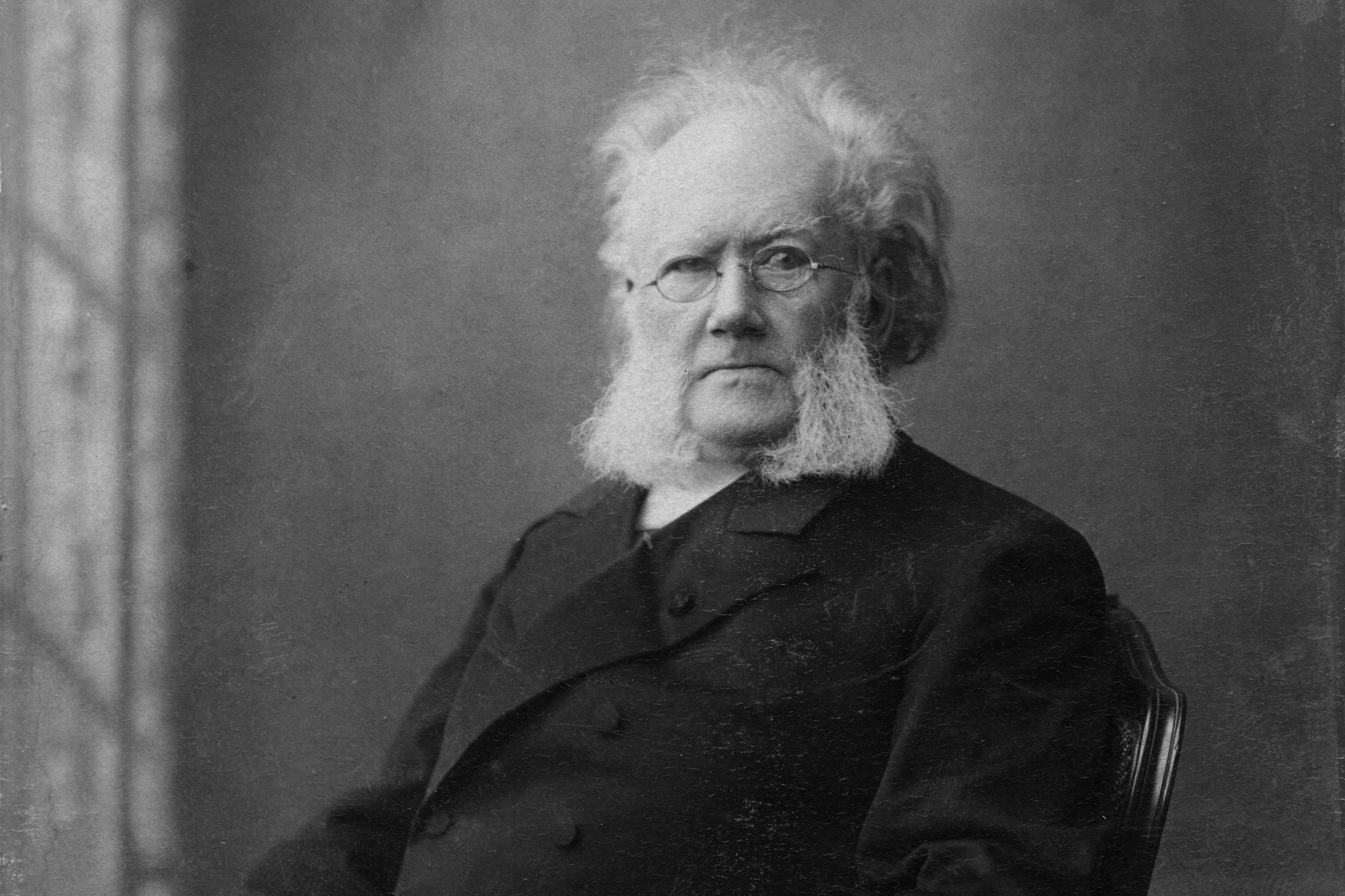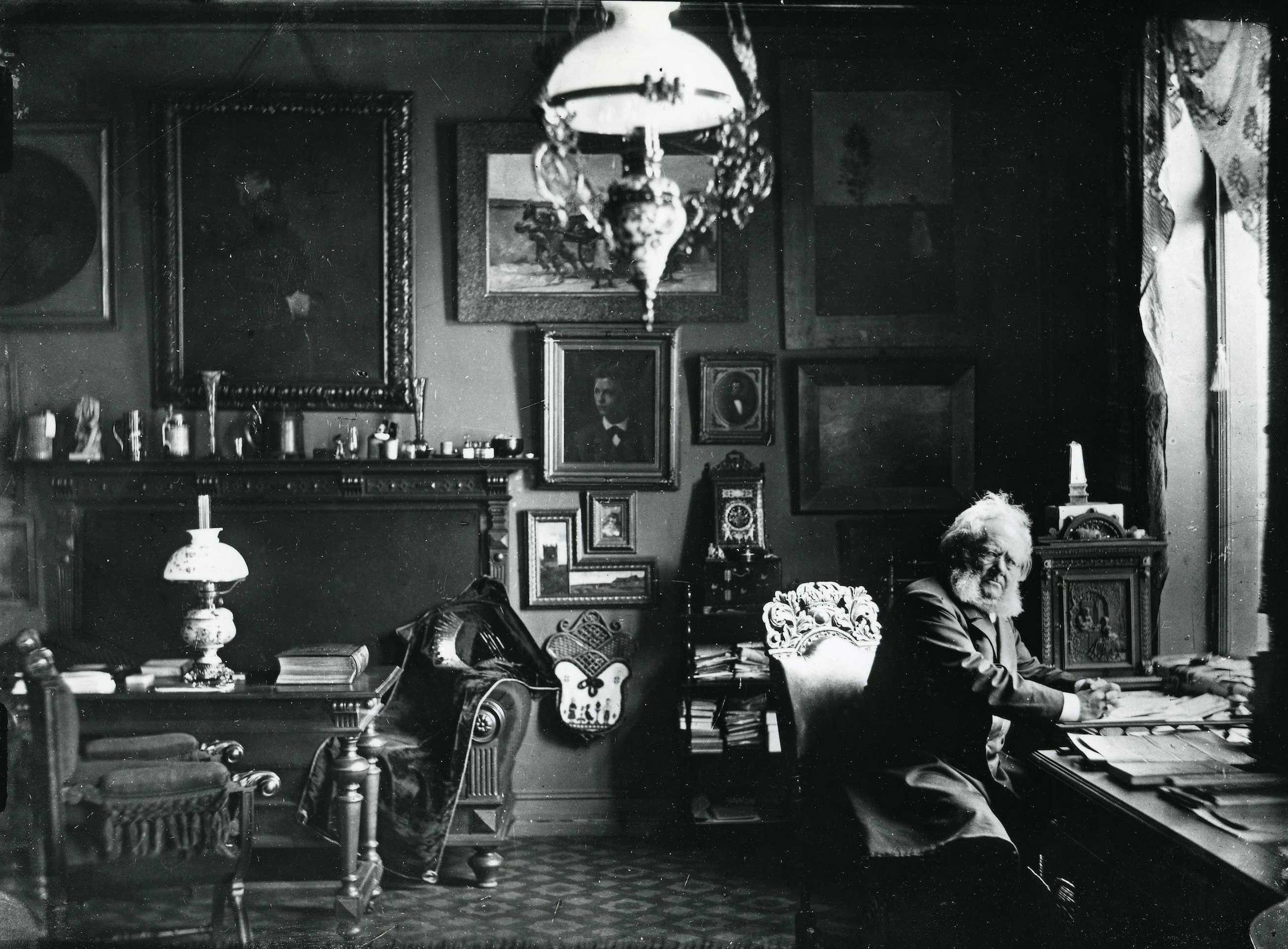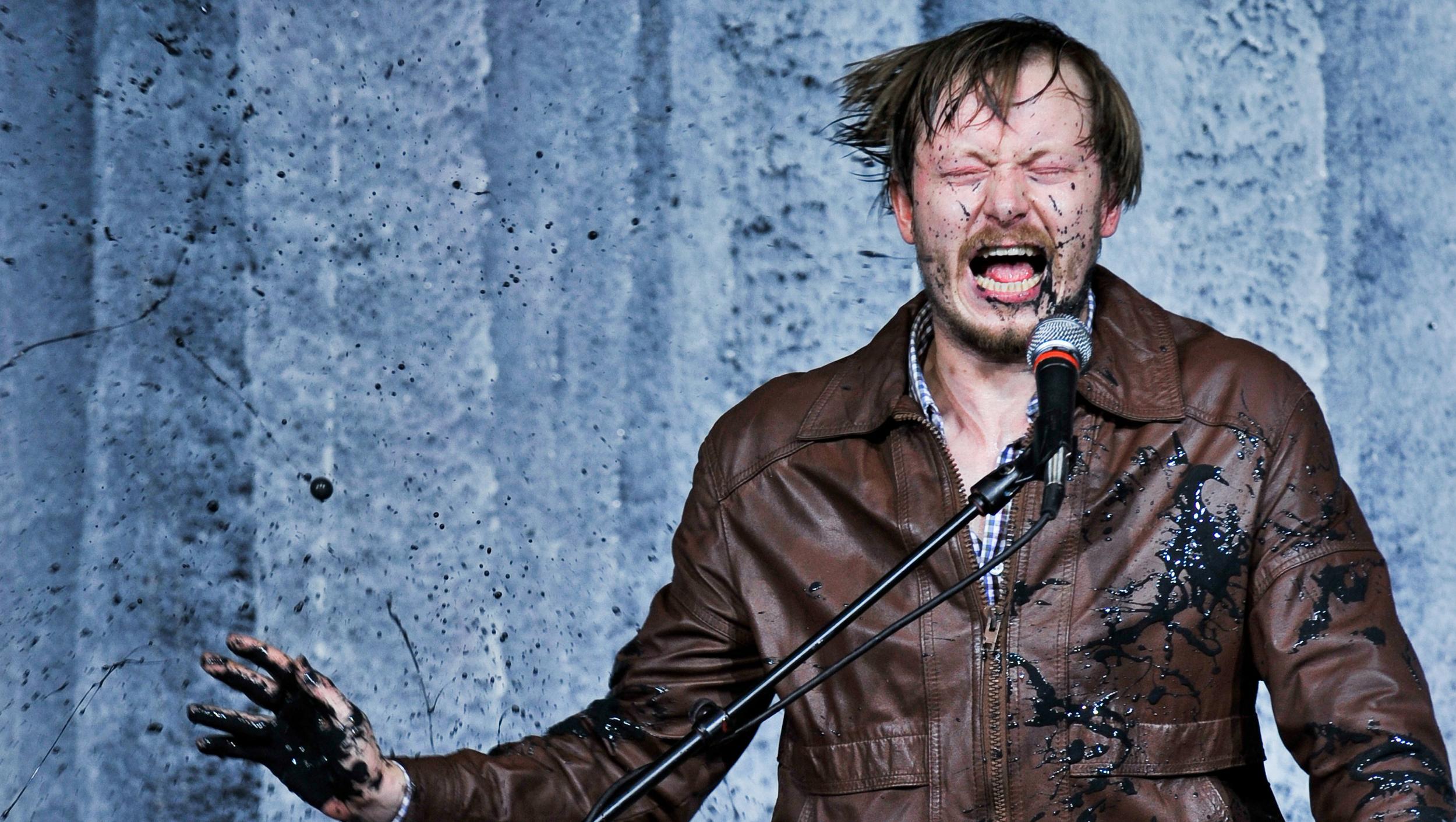Ibsen:
the unlikely radical
A writer of maudlin period melodramas – or a provocateur whose plays can still surprise and shock? Andrew Dickson on Ibsen, our contemporary
A visit to the Ibsen Museum in Oslo is a sobering experience. Up a narrow set of stairs, vigilantly policed by tour guides, lies a second-floor apartment preserved exactly as it was at the playwright’s death on 23 May 1906.
A grand salon, heavy with dark velvet and stiff brocade, is lined with portraits. One of the largest is of Ibsen himself, swathed crow-like in a black academic gown. Next door is a formal dining room – inlaid parquet floor, severe oak furniture – and beyond that The Blue Parlour, where the playwright received guests beneath a ghoulish candelabra that wouldn’t look out of place on the set of the Addams Family.
From the windows one can gaze down upon the route the elderly Ibsen patrolled each day at exactly 1pm, after a serious morning’s work: down Drammensveien, skirting the grounds of the royal palace, past the National Theatre and towards the city’s Grand Cafe, where a table was kept permanently reserved for him.
On the street itself, a life-size bronze of the playwright now scowls at the world, top hat jammed down on his head, arms resting on a cane the thickness of a steel girder. He looks like he might lash out if you venture too close.

This is our image of Ibsen, at least in Britain. Inscrutable. Moralising. Philosophical. The Sage of Skien. Forbiddingly complex. Even more forbiddingly bearded. He is the writer of angst-ridden plays set in suffocating Nordic rooms where the only relief – and relief it never is – is a view of a brooding fjord. It’s a world of 'dark-crimson serge tablecloths with chenille bobbles, black horsehair sofas, wall brackets and huge intellectual women in raincoats and rubbers' (the description is by the great twentieth-century director Tyrone Guthrie).
But there is, I think, another Ibsen. This is an Ibsen who was a political radical, who maintained a decade-long correspondence with one of Europe’s leading feminists, and was hailed as a hero of the suffragette movement. A playwright whose scripts were considered so explosively amoral that several were banned in his lifetime. A Norwegian who struggled to find acceptance in the country of his birth, and lived much of his life in exile. A respectable husband and father who spent forty years attempting to escape a dark sexual secret in his past.
The more closely you look at Ibsen, in fact, the stranger and more beguiling he gets. Behind all that brocade perhaps something much more dangerous and interesting lurks.


In the wilderness
Almost the strangest fact about Ibsen is that he managed to make a career as a writer at all. Born in 1828 in the remote logging community of Skien, about seventy miles south of Oslo, his early life was thrown into tumult when his merchant father gambled away the family fortune on a series of chancy investments.
Ruined and humiliated, Knud Ibsen brought the family – including the seven-year-old Henrik – to live in a dilapidated farmhouse in the barren countryside. The Ibsens lived hand-to-mouth; despite the artistic aspirations of his mother Marichen, there was barely enough money to send Henrik to school. At 15 he left formal education altogether, becoming an apprentice to a pharmacist in Grimstad, a town hardly bigger than Skien.
Grimstad – a place he later called 'primitive and impecunious' – was the setting for an incident whose consequences would shadow Ibsen for the rest of his life. While lodging in the pharmacist’s house, he became involved with a woman who was working as a servant, Else Sofie Jensdatter; in October 1846 she gave birth to a boy, Hans Jacob. She was 28; Ibsen was 18.
Horrified by the possibility of scandal, Ibsen attempted to disown the child, and only paid maintenance under legal duress. Else later went blind and died in poverty; Hans himself became an alcoholic and struggled to hold down work. Legend has it that Ibsen and Hans only met as adults, four decades later, when Hans came to beg at his famous father’s door. It is equally possible they never made contact.
Whatever the truth, by then Ibsen was desperate to be anything but a trainee pharmacist, and living anywhere but Grimstad. He applied to the University of Christiana (later Oslo), but failed his matriculation exams. He considered a career as a doctor. He began to paint, and write poems. In 1849, he completed work on the first draft of his first play, based on the story of Catiline, a senator who attempted to overthrow the Roman Republic. No publisher or theatre would accept it; in 1850, the author paid for it to be published himself. He was later forced to sell copies for scrap paper.
Given the taut construction and dense thematic tapestries of his mature work, it comes a shock to realise how long it took Ibsen to find his feet as a dramatist. His second play, The Burial Mound, was a one-act verse melodrama about the unlikely subject of Vikings; his third, St John’s Night, was a fairytale comedy that has reminded some critics of Gilbert and Sullivan.
Even when he got his big theatrical break in 1851 – a job at the newly founded Norske Theater in Bergen – it proved a torment. Ibsen struggled with poor actors, inadequate facilities and a series of melodramatic scripts by other writers that almost destroyed his taste for drama altogether. His own plays were not well-received; despite attempts to write crowd-pleasing ballad dramas, he was floundering.
New horizons
Two events were to change Ibsen’s life and work for good.
One was meeting his future wife, a strong-willed and well-connected woman called Suzannah Daae Thoresen, whose stepmother Magdalene was a leading light of the Bergen intelligentsia and was making a name for herself – remarkably for the time – as a poet and playwright.
Suzannah herself was fiercely intelligent and widely read; she was immediately attracted to Ibsen, and he thrilled to the new worlds she opened up. It was via her that he became acquainted with the intellectual Camilla Collett, who as well as being the founder of the feminist movement in Norway also pioneered the Norwegian realistic novel.
Collett became a close friend, and her incendiary thinking about women’s rights left its mark on Ibsen’s plays in countless ways. Suzannah remained Ibsen’s sternest critic as well as his doughtiest defender.
The other turning point was of even greater significance: a short trip Ibsen made to Germany and Denmark in 1852, which allowed him to see for himself some of Europe’s leading theatres and watch Shakespeare on stage for the very first time, as well as an eye-opening selection of avant-garde drama. The 24-year-old playwright was thrilled to see what life outside Norway was like, and it fed his determination to see more of the world.
When his next permanent job, at the Norwegian Theatre in Christiana, went sour – the theatre ended up going bankrupt, and Ibsen was still struggling to write a play he could be confident in – he and Suzannah and their son Sigurd decided to abandon Norway altogether. Nearly all of Ibsen’s major work was written in exile, first in Rome, then in Dresden and Munich.
They would not return to Christiana for 27 years.
Feminists and freedom
Ibsen’s plays have become such a central part of the repertoire that it is easy to forget how mould-breaking they were. The first script he completed in Rome, Brand (1866), provoked impassioned debate with its unsparing portrayal of a preacher grappling to accommodate his beliefs with his humanity. Widely interpreted as an attack on conventional religion and society, it was deemed dangerously unpatriotic.
1879’s A Doll’s House was even more earth-shattering. Written in tough, idiomatic prose, the play was fervently contemporary and unashamedly political. In his early notes Ibsen had written that 'a woman cannot be herself in contemporary society, it is an exclusively male society with laws drafted by men, and with counsel and judges who judge feminine conduct from the male point of view'.
The play itself dramatises that conundrum, with its depiction of a young married woman, Nora Helmer, who is caught between her requirement to be a doe-eyed mother and wife (her husband’s innocent 'skylark' and 'squirrel') and the fact that she has secretly forged a signature on a loan to get them out of financial trouble. When the truth emerges, Nora realises that her marriage has been a dishonest sham. She leaves with what has been called the most famous door-slam in history.
'I must stand on my own two feet if I'm to get to know myself and the world outside. That's why I can't stay here with you any longer'
Although Ibsen’s precise views on feminism have often been debated (with customary opaqueness, he told the Norwegian Women’s Rights League in 1898: 'I am not even quite clear as to just what this women’s rights movement really is'), A Doll’s House was undeniably a landmark: a play that depicts a woman coming to terms with the restrictions of her life and taking control of her destiny.
This is a theme that would reappear obsessively in Ibsen’s work, from Hedda Gabler (where a stultifying marriage and unwanted pregnancy leads Hedda to take her own life) to Little Eyolf (in which Rita Allmers’ passionate sexuality proves too much for her husband to bear) to the yearning late play The Lady from the Sea, whose heroine strives to reconcile her marriage to a dull local medic and the mysterious stranger who blazed through her youth.
Such was the anxiety A Doll’s House provoked in European society that Ibsen’s German translator asked him to provide an alternative ending in which Nora stays with her children; the playwright reluctantly complied, but later disowned it. And the play’s galvanising effect was clear. As early as the 1880s A Doll’s House was acclaimed as a 'miracle' by the pioneering suffragette Gina Krog. When it was finally staged in England in its original form in 1889, translated by the feminist and Fabian Eleanor Marx (daughter of Karl), it caused uproar in radical circles. Another radical feminist, Edith Lees Ellis, wrote: 'That a woman should demand her own emancipation and leave her husband and children in order to get it, savoured less of sacrifice than sorcery.'
Director of the Ibsen Museum in Oslo, Erik Edvardsen, discusses Ibsen's thoughts on freedom
'An open drain; a loathsome sore unbandaged; a dirty act done publicly'
All this was as nothing compared to the most confrontational work of Ibsen’s first mature period, Ghosts. The story of a woman who leaves her philandering husband and then returns to tragic consequences – A Doll’s House, the morning after the door-slam – it blended themes of moral doubt, religious despair and ravening sexual hypocrisy, all set beneath louring northern-European skies. When it is revealed that the immaculately respectable Captain Alving’s chief legacies to his son have been a half-sister fathered with a servant and a case of inherited syphilis, it seems as if an entire society is on the brink. Was it also a way of atoning for Ibsen’s own affair, 35 years before? He was tight-lipped on the matter.
Ibsen had been prepared for controversy, but even he was stunned by the reaction when Ghosts was published in 1881: several countries banned it altogether, among them Britain, and it was first staged in Chicago.
When the script was finally performed in London ten years later (one night only in a private performance to evade the censor), the Telegraph reviewer called it 'an open drain; a loathsome sore unbandaged; a dirty act done publicly'. Nearly 500 articles were written in response to the production. In his own country, it took over a decade for Ibsen to be forgiven.
The hysterical response to Ghosts was a major impetus behind An Enemy of the People, written soon afterwards. Depicting an idealistic doctor called Stockmann who launches a campaign against weak-willed local politicians, the play reworked what Ibsen felt on doomier days to be his own position: an isolated voice in the wilderness, raging against the deceptions of mainstream society and – just perhaps – the contradictions in himself.
Ibsen Updated
Although in continental Europe Ibsen is often interpreted as a contemporary writer, able to speak to issues as varied as HIV/Aids and the effects of the credit crunch, here in Britain we have a harder time making him talk our language. The plots of his plays – a man tries to tell the truth about corruption and is turned upon by a restive mob, a woman finds she is pregnant and decides the only way out is suicide – could barely seem more urgent. A few tweaks and they could make it into this week’s EastEnders, or tomorrow’s tabloids.
But the lingering effects of Stanislavskian realism, not to mention a Downton-like taste for period detail, have made his plays seem more about the dangers of excessive crinoline- and frockcoat-wearing than anything more politically pertinent. Otherwise fine British productions of A Doll’s House and Hedda – and there have been many – are swaddled in chintz and antimacassars, as if Ibsen were Julian Fellowes in angrier, Nordic form.
That’s a pity. We would do well to see Ibsen’s plays for what they are: fierce assaults on conventions we still hold dear, explosive devices primed to blow through the lies we tell ourselves.
That’s not to say things aren’t changing. In 2013, Birmingham Rep staged a version of Hedda called Heather Gardner, set in Edgbaston during 1962. Little Eyolf has been adapted to the 1950s by Samuel Adamson; A Doll’s House staged at the West Yorkshire Playhouse in a contemporary production influenced by Channel 4’s Wife Swap.
But for productions that reveal the present-day discontents in Ibsen’s scripts, you still need to travel outside the UK. Dublin’s Abbey blazed a trail with a 1990 version of Ghosts where HIV, not syphilis, was a father’s grim legacy to his child. Germany – a country which has, of course, deep links with Ibsen – has developed a minor industry in pioneering reimaginings, from Peter Stein’s Brechtian, six-and-a-half-hour Peer Gynt in 1971 (part of which took place beneath a vast cyclorama of the Sphinx at Giza) to a heavily stylised Rosmerholm by Peter Zadek to Sebastian Neubling’s Dracula- and Karl Marx-influenced John Gabriel Borkman (both 2001).


One of the most exciting directors currently working in Europe is the Berlin-based Thomas Ostermeier, who made his name with tough-minded stagings of scripts by Sarah Kane and Mark Ravenhill, and has in recent years developed a reputation for stylish and startling remakes of classic texts – Hamlet dismembered and reassembled as a satire on avant-garde theatre; Death in Venice made into a troubling meditation on paedophilia, shot in live video.
But it is in Ibsen that Ostermeier has found a radical voice that echoes his own. His 2003 Doll’s House, set in a beautifully stylish upper-middle-class home that came straight from the pages of Elle Decoration, took aim at the emptiness of modern, money-obsessed lifestyles. Nora departed not with a door-slam but by pulling a gun.
Ostermeier’s most recent Ibsen, 2012’s An Enemy of the People, goes further still, mixing the text with an anarchist manifesto culled from the web and capturing the era of Snowden and Wikileaks with uncanny accuracy. When Stockmann tears down the fourth wall and forces the audience into a debate about the manifold evils of society, it feels dangerously close to an insurrection – although which side you’re on is left tantalisingly open.
When I saw Enemy at the Schaubühne in Berlin last autumn, it provoked walk-outs and outraged condemnation; when I came out of the auditorium, a woman was standing at the box office, angrily demanding a refund. The show was undeniably divisive, but as I left the theatre, I couldn’t help thinking that divisiveness is very much the point. Ibsen, surely, would approve.
Words: Andrew Dickson
Film and photography: Siddharth Khajuria
Production shots: Arno Declair (An Enemy of the People), Heidrun Löhr (The Wild Duck), Monika Ritterhaus (Peer Gynt)
Digital production: Ryan Nelson, Rachel Williams, Siddharth Khajuria
Archive material courtesy of Ibsen Museum, Oslo and the National Library of Norway
Thanks to Visit Oslo and Visit Bergen
Supported by the Royal Norwegian Embassy in London
International Ibsen season
Incisive, intense and impactful, our International Ibsen Season fearlessly transports three plays to the contemporary age, illuminating issues that resonate powerfully today. Expect rock star royalty, voyeurism, blackouts, public debate and even a hint of the Occupy movement.
An Enemy of the People | 24–28 Sep
Schaubühne’s potent adaptation catapults Ibsen into a modern world of environmental and financial crises, becoming a mirror for our times.
Peer Gynt | 8–11 Oct
Ibsen's famous hero becomes rock royalty in this 21st century reboot featuring songs by Iggy Pop and new writing by Sam Shepard.
The Wild Duck | 23 Oct–1 Nov
The Wild Duck is reimagined for the modern stage, with the action unfolding within a glass enclosure.
Contemporary Ibsen in performance: panel discussion | 25 Oct
Join a panel of international theatre practitioners and academics for an in-depth discussion on the challenges and opportunities for contemporary stagings of Ibsen.